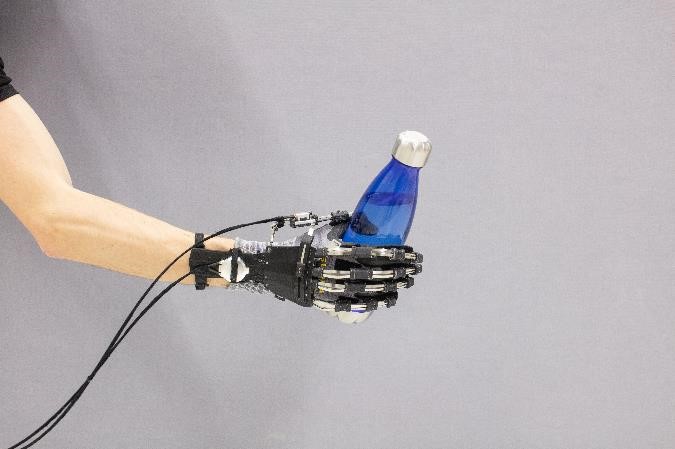3D printing with iglidur polymers in medical technology
Maria Burkanova | 25. March 2020
Medical technology is an important driver of 3D printing technologies: highly customisable products offer unprecedented opportunities for a wide range of medical solutions. Components from 3D printers are used in the production of individually manufactured components for patients, such as hearing aids. Hospitals are acquiring their own 3D printers so that they can quickly create replacement parts and accessories for laboratories and machines. Rapid prototyping technologies make product development for innovative laboratory and therapeutic equipment and medical furniture much faster and more economical, so that optimised solutions reach the market quicker and are available for the medical industry.
For periods of crisis and in poor countries, 3D printing offers fast, efficient capabilities. For instance, during the current coronavirus pandemic, several companies have been able to print components for ventilators, protective masks and hospital equipment in a very short time and get them where they are needed.In parts of the world where replacement parts for medical devices, laboratory equipment and prostheses must be imported at great cost and wait times are long, locally available 3D printers can be a quick, low-cost solution for procuring urgently needed products.
Innovative solutions from medical technology and 3D printing
Additive technologies are especially innovative in the area of implant and prosthesis manufacture. The trend goes even further – initial studies have been done on functioning organs printed from organic material. Artificial organs are being used as early surgeon training. They are also used in preparation for complicated operations. In order for them to be implanted in humans one day as replacements for diseased or damaged organs, intensive research is being conducted to discover the special materials and procedures needed.
3D printing is also used to help generate innovative solutions in the development and manufacture of medical devices and laboratory equipment. Fast prototype construction is used extensively in the development of highly specialised solutions. These solutions are often very specific equipment for hospitals and laboratories and are manufactured in small quantities. Conventional manufacturing procedures entail great expenses for such items as the mould cast; these expenses are unnecessary for 3D printing, so the final products cost less. Of course, special machines often require special materials – depending on application, they may need to be cleanroom compatible, bacteria-repellent, resistant to aggressive chemicals or suitable for autoclave.
What is especially important for 3D printing solutions for medical devices?
When mechanical components are used in hospitals or for manufacture of medical products, it is especially important for them to be cleaned thoroughly and disinfected. In order to prevent germs or bacteria from attaching to surfaces, it is important either for materials used, to already have smooth surfaces, or for the surfaces to be smoothed after printing. Some devices must be suitable for autoclave – and the material must also be able to handle it without disintegrating due to collected water. PEEK and PPSU plastics are usually used for this. The official requirements for approval of a medical machine are especially stringent and must be taken into account as early as design and material selection.
Weight is especially important in prostheses and support mechanisms – the lighter the individual parts, the easier the handling for the end user. But friction and wear musn’t be neglected – movement must be easy and flowing, and regular component replacement requires a great deal of cost and effort.
What medical machines already use 3D printed igus parts?
Products such as plain bearings, linear guides and energy chains made of high-performance igus polymers have been used in various areas of medical technology. Lubrication-free, cleanroom compatible, media-resistant, corrosion-free, quiet – all these properties make igus products ideal for a number of medical devices and prostheses. The large portfolio of special plastics includes numerous solutions for cleanroom applications and chemical-resistant polymers suitable for autoclave that can be used in the design of wear-resistant components.

3D printed parts from iglidur filaments and laser sintering powder already ensure lubrication-free, low-friction running, including in blood analysis equipment
- Incubators
- Thermal shakers
- Syringe pumps
- Dialysis machines.
- Packaging machines for blood vials and medications
Among the most commonly asked-for parts are gears , for complex lead screw nuts and complex individual customer components. Even though there are as yet no cleanroom-compatible 3D printed igus materials, customers from the medical industry know and appreciate the wear-resistant igus polymer parts and their quick availability, which is why they go for iglidur filaments and laser sintered parts for individual functional components and functional prototypes.
Such parts (finger joints in this case) were used in the design of a hand exoskeleton. A team from the Eidgenössische Technische Hochschule Zürich (ETHZ) constructed a hand exoskeleton of 3D printed iglidur materials that is to support stroke patients in relearning gripping movements. It is especially important for the material to be lightweight and low-friction, since excess weight or friction would impair the exoskeleton’s functionality.

What solutions does igus 3D printing offer for medical technology?
In our 3D printing service, replacement parts, prototypes and abrasion-resistant components can be ordered online. Lead screw nuts, gears, rollers, plain bearings and sliding elements can be designed online free of charge with the CAD configurators and ordered in the right material with the iglidur Designer. While parts made of iglidur I3 are especially well suited to complex components for which low friction and high wear resistance are especially important, iglidur I6 offers additional strength for components to which heavy loads are applied.
Our filament selection also offers solutions that can be used in the medical industry: iglidur A350 is a high-temperature filament developed primarily for applications that will contact food, but is also suited to use in some medical technology areas. Would you like to test our filaments? Just order a product sample that suits your needs, free of charge. You can ask for one for a specific product in our filament shop.

